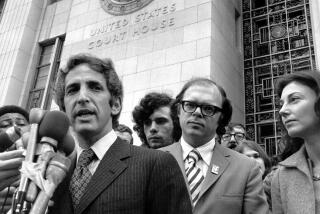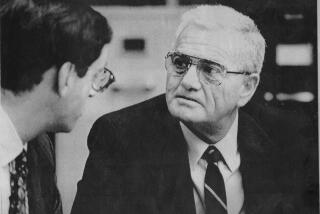David Greenglass dies at 92; ‘40s A-bomb spy who betrayed his sister
David Greenglass knew how history would remember him. He was “the spy that turned his family in.”
His confession was key to the government’s case against Ethel Rosenberg — Greenglass’ sister — and her husband, Julius, who were executed in 1953 for passing atomic secrets to the Soviet Union in the most notorious espionage case of the Cold War era.
Later, his betrayal was burned into cultural memory. Greenglass inspired the contemptible Selig Mindish, the protagonist of E.L. Doctorow’s 1971 novel based on the Rosenberg case, “The Book of Daniel.” His name was invoked in “Crimes and Misdemeanors,” the 1989 Woody Allen film in which Allen’s character says of a loathsome relative, “I love him like a brother — David Greenglass.”
Greenglass, an Army machinist who spent a decade in prison for passing nuclear secrets to the Rosenbergs and later admitted that he had lied about a crucial part of his incriminating testimony, died July 1. He was 92.
His death, which was not announced publicly at the time, was confirmed Tuesday by his attorney, Daniel N. Arshack, who declined to give any details other than that Greenglass died “somewhere in New York state.”
Since his release from prison in 1960, Greenglass had lived under an assumed name in the New York City area. He avoided the spotlight until 2001, when he admitted in the book “The Brother” by Sam Roberts that he had lied about Ethel Rosenberg’s involvement in her husband’s spying to save his own wife.
The Rosenbergs’ convictions in 1951 bolstered Sen. Joseph McCarthy’s campaign to expose Communists in the government and other fields. The only people executed in the United States for Cold War espionage went to their deaths as martyrs.
Their supporters clung to their views of the couple as victims of the Red Scare until 1995, when the U.S. government released Soviet intelligence cables that had been intercepted and deciphered in the 1940s.
The declassified documents, known as the Venona transcripts, provided incontrovertible evidence of Julius Rosenberg’s involvement in a Soviet spy ring, but how valuable his information was — and whether either he or his wife deserved to die — are questions that historians and others continue to debate.
When a group of historians petitioned the government for the release of grand jury testimony from the Rosenberg case, Greenglass refused to allow his testimony to be made public.
His attorney told the court in 2008 that Greenglass and his family wished to avoid the “unwanted spotlight which has dogged their lives ever since” he emerged as a crucial witness in what FBI Director J. Edgar Hoover had called the “trial of the century.”
“He was a man who impressed me [as] having very little morality, a man governed by situational ethics,” Roberts, a New York Times editor who pursued Greenglass for 13 years, told National Public Radio in 2001.
Ronald Radosh, a historian of the Rosenberg affair who interviewed Greenglass extensively in 1978, had a different view.
“Greenglass may not have been a hero,” Radosh said Tuesday, “but as soon as he saw the government had the evidence that espionage was conducted, he realized the only way out was to own up to his guilt. He saved his own life. I don’t fault him for making that decision.”
Although he displayed an early aptitude for machines and gadgetry, Greenglass, the youngest of four children, often went to the movies instead of helping out at his father’s repair shop. He had a reputation as a loudmouth and windbag.
He was 14 when his sister Ethel began to date Julius Rosenberg, an electrical engineering major who was embroiled in leftist politics. Julius encouraged David’s interest in science and persuaded him to join the Young Communist League. On the witness stand years later, Greenglass would describe Julius as his hero.
In 1942, Greenglass married his childhood sweetheart, Ruth Printz. He was working as a machinist when he was drafted into the Army in 1943.
He served at Army posts in California and Tennessee before being assigned to the top-secret weapons laboratory at Los Alamos, N.M., in mid-1944 with a full security clearance. No one asked if he had ever been a Communist, and he deliberately omitted from the security questionnaire his membership in the Young Communist League.
Back in New York, Ruth too had joined the league and attended political rallies with Ethel and Julius. By late 1944, Julius, who had learned through his contacts that David’s assignment involved the atom bomb, had enlisted Ruth as an intermediary. Her job was to ask David if he would engage in espionage.
On a weekend in December 1944, she met her husband in Albuquerque and put the question to him. He quickly agreed, believing that stealing atomic secrets would help a U.S. ally, the Soviet Union, and create a balance of nuclear power.
Soon he had a Soviet code name, Kalibr.
Spying, Greenglass later told Roberts, was not particularly hard work. He did not have to furtively search cabinets and desks for classified documents. He picked up information about trigger mechanisms and the bomb’s plutonium core through eavesdropping and casual conversations with scientists, who considered him “too stupid and too outspoken to be a spy,” Roberts wrote.
Security at Los Alamos was so lax that Greenglass slipped a cartridge for an exploding-wire detonator into his pocket and walked out the door with it.
In June 1945 Greenglass met Soviet agent Harold Gold in New Mexico to hand over his first batch of secrets: sketches of a high-explosive lens mold and a list of co-workers who might be ripe for spy work. Gold paid him $500.
“I felt there should have been more,” Greenglass said in Roberts’ book, “but somebody gives me money, I take it.”
A few weeks later, on July 16, 1945, the first test of the atomic bomb took place in the New Mexico desert. On Aug. 6, the bomb was dropped on Hiroshima, Japan.
In September, Greenglass went to New York on home leave. He turned over a drawing of the bomb and a sheaf of handwritten notes to the Rosenbergs at their apartment.
The importance of Greenglass’ stolen information would later be contested. Both Soviet and American experts would characterize his notes and sketches as relatively inconsequential, providing at most corroboration of details already known to the Soviets.
But Ethel Rosenberg’s fate would turn on those notes, which were never recovered by investigators.
Greenglass was arrested in 1950 and not only confessed to being a spy but fingered both his wife and Julius as co-conspirators. He promised the government his full cooperation in exchange for immunity for Ruth Greenglass. The government agreed, and Ruth was never indicted.
Although Greenglass had not implicated his sister at this point, the government eventually arrested the mother of two boys to pressure Julius, who had been taken into custody shortly after his brother-in-law.
Ten days before the Rosenbergs’ trial was to begin, Ruth Greenglass told government investigators that Ethel had typed up the notes David had given Julius at the Rosenbergs’ apartment. Upon re-questioning, David corroborated Ruth’s account.
At the close of the trial, the allegation was used to maximum effect by federal prosecutor Irving Saypol. He told the jury that in typing up Greenglass’ description of the atom bomb Ethel Rosenberg had “struck the keys, blow by blow, against her own country.”
Half a century later, Greenglass confessed to Roberts that he had no memory of Ethel typing up his notes. “I frankly think my wife did the typing,” he told Roberts, “but I don’t remember.”
When the grand jury transcripts were released in 2008 historians said the files showed “irreconcilable” differences between Ruth Greenglass’ grand jury testimony and the remarks she made under oath at the Rosenbergs’ trial. She told the grand jury that she had hand-written the information that her husband had stolen. She later told Radosh that she could not remember ever saying that the notes had been typed.
To what degree, if any, Ethel Rosenberg was involved in her husband’s spying may never be known. Morton Sobell, who had been convicted along with the Rosenbergs, told the New York Times in 2008 that she was aware of her husband’s activity but did not directly participate in it.
Greenglass insisted that he had tried to save his sister.
“I told them the story and left her out of it, right?” he told Roberts. “But my wife put her in it. So what am I gonna do, call my wife a liar?
“My wife is more important to me than my sister…” he said. “And she was the mother of my children.”
Ruth Greenglass died in 2008. Greenglass is survived by two children and grandchildren.
The Rosenbergs were on death row for two years before Greenglass wrote a letter to President Eisenhower to plead for leniency. “I would be less than human if I did not state that if these two die, I shall live the rest of my life with a very dark shadow on my conscience,” he wrote.
At the same time he blamed them for not saving themselves by confessing. That they failed to do so — and made orphans of their two young sons — was, Greenglass said, “stupidity.”
“What Greenglass did is unforgivable,” Robert Meeropol, the Rosenbergs’ younger son, told a Canadian interviewer in 2003. “On a personal level, he is dead to me.”
Robert and his brother, Michael, were adopted by another couple, Abel and Anne Meeropol, after their parents’ execution at Sing Sing, and had no contact with Greenglass in the ensuing decades.
If given a chance to speak to his nephews, Greenglass told Roberts, he would say that he was sorry their mother and father were dead.
Twitter: @ewooLATimes
More to Read
Start your day right
Sign up for Essential California for the L.A. Times biggest news, features and recommendations in your inbox six days a week.
You may occasionally receive promotional content from the Los Angeles Times.







